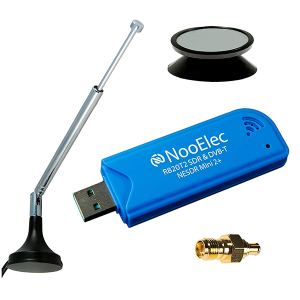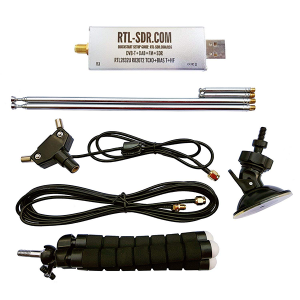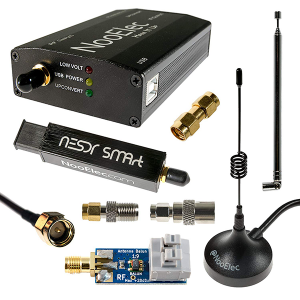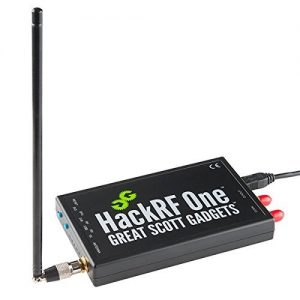There are a lot of SDR kits out there so finding the best cheap RTL type SDR kit to get started with can be a daunting task. Fortunately we have played with a lot of them so we can help guide you along the path to finding the one that suits your needs. This article is for people brand new to SDRs who are unsure of the best place to start. Those who want to dip their toe in so to speak, not spend a lot and find out it isn’t that interesting to them.
What is a SDR?
SDR (Software Defined Radio) receivers are radios which have had some of their traditional components such as modulators, and tuners replaced by software and programmable chips in a very small circuit. This allows the radio to be extremely small, inexpensive, and very flexible. A typical FM radio will tune from 88 to 108 MHz whereas a typical cheap SDR will tune from 500 kHz up to over 1.7 GHz.
This makes these types of radios perfect for scanners as they can access a wide range of services such as police, fire, amateur radio, satellites, aircraft, marine, sporting events, and much more. It also makes them perfect for people wanting to learn more about how radio works.
What is a RTL SDR?
Cheap SDR receivers are generally based on the RTL2832U chipset which was originally designed for receiving digital television. These little units are the basis of virtually all cheap SDR units out there today.
The chip is mounted with all the necessary support electronics on a circuit board not any bigger than an old school stick of gum, or a typical USB thumb drive. This tiny package includes a USB port which provides all needed power as well as allows it to talk directly to the computer you plug it into.
Finding the right RTL SDR
If you do a quick search for RTL SDR units anywhere online you are sure to find them sold by RTL-SDR Blog, NooElec, Radioddity, Zerone, and many others. To make it even more difficult, each of those brands may have a slew of different models, and then several different kits for each model. It can be exhausting trying to pick one out.
What follows is based on playing with more of these SDR units than we will ever admit to. We have tested them to see how they work with nothing but what comes with them, and then with upgraded antennas etc. We have also used them on a variety of computers which includes Windows, Mac, and Linux machines with different software packages such as our favorites; SDR# (free, Windows) and GQRX (free, Mac & Linux) .
The first concern is which tuner has been mated to the RTL2832U chip. The best was widely considered to be the E4000 as it allowed tuning from 60MHz to 1700MHz which was about the widest available. As things progressed this tuner became less and less available and was supplanted by the R820T and now the R820T2 which has a range of 24MHz to 1850MHz (or 25MHz-1750MHz depending on who you ask) while being cheaper than the E4000.
Be sure to stay away from the FC0012 and FC0013 tuners that only have a range of 50MHz to 1000MHz and are generally less well supported than the E4000, R820T, and R820T2.
Another feature that people put a lot of concern into with their RTLSDR is the antenna connection. I find this a little less important than most because few people will be doing serious work with a RTLSDR so a serious antenna is not really required. For example, a really good scanner antenna would be the Diamond D3000N Super Discone Antenna which runs about $150, then you need 50′ of LMR-400 cable to connect it for another $100, then an adapter for $20 to connect it to whatever you are using for a SDR and finally, an antenna mast and mount for another $20. How many people do you know who want to connect a $25 SDR to $290 worth of antenna gear (not including clamps, bolts, screws, etc)?
Sure you could use a cheaper antenna and cable, but if we are going to climb our butts up on a ladder to the roof, or up on the roof, to mount an antenna, we want it to be a good one so we don’t have to ever do that again. Using a cheap antenna or cable just makes us do a lot of work for not a lot of return.
Besides, most of the SDRs can simply use an adapter to connect to anything including the N or PL259 types used in professional antenna installations. Funny enough though, a good PL259 on an LMR-400 cable is bigger than most of the RTLSDRs you will find so it looks a bit strange.
The recommendations

My favorite recommendation is the NooElec NESDR Mini 2+ kit you can get on Amazon for around $24 which includes the SDR, antenna adapter, extendable antenna with suction cup mount that also work magnetically. The cable, while only about a meter long, does allow you to put the antenna near a window or at the edge of your desk away from any electronics which helps improve reception quite a bit. If you really want to move that antenna further away and potentially outside that window you could use something like a MCX Antenna Extension Cable (10 Feet) to get it out there. Full disclosure, no one here has actually used one of these extension cables however we have heard that they work pretty well, but can be a little temperamental to keep connected. In other words, if you move the cable the connections can come lose.
I would not use anything longer than the 10 foot cable listed above as you would be introducing so much loss in that little flimsy cable that your reception would probably be horrible no matter where you put the antenna.
This is probably the perfect introductory kit to SDR. Cheap, easy to use, and flexible enough to do a lot with makes this as close to a perfect starter kit as you are likely to find. It is also small and sleek enough to be an excellent unit to pair with your Raspberry PI.

Nest up is the RTL-SDR Blog R820T2 RTL2832U 1PPM TCXO SMA Software Defined Radio kit for about $30 which comes with a really great set of antennas, an extension cable for the antenna, and is in a really nice all metal housing.
So with all this awesomeness and only costing $6 more than the one above, why is this one in the second place spot? Issues with using it making it a bit more frustrating even with all the additional cool stuff.
Let’s start with this thing’s tendency to overheat. Since the boards in this unit and the NooElec above are very similar, and this thing is in a metal heatsink of an enclosure, you would think it would run cooler. That is incorrect, it runs hotter. Maybe it is the vent holes in the NooElec that keep it cooler and prevent errors and shutdowns, we don’t know. What we do know is that if you want to use this device outside, in an attic, or any place that isn’t well air conditioned, be warned you may have problems.
If on the other hand, you use it strictly in your air conditioned home and it is on your desk with plenty of airflow, this is an excellent unit.
We loved all the antenna pieces parts that allow for multiple configurations, and the ability to use the little flexible tripod is amazing! Sure, some of the accessories have to be treated carefully because they are cheap (what do you expect for $30?) but with a little care you have a much better chance of receiving signals than the with some of the other kits.

The most expensive of our “cheap” SDR kits is the NooElec NESDR Smart HF Bundle which runs about $90. As you can see in the image above, this kit includes two different antennas and several antenna adapters. This really is the ultimate little SDR tinkerer kit for anyone who wants to play around with SDRs. Included is their Ham It Up unit which extends the usable frequency range from 100kHz to 1.7GHz which captures the amateur radio bands in addition to all the normal stuff.
The only real down side with this kit is the antennas included could be better like with the RTL-SDR Blog R820T2 RTL2832U 1PPM TCXO SMA Software Defined Radio kit listed above. It does however have several antenna adapters and the Ham It Up box so I have to cut it some slack. If you want to be able to listen to the maximum amount of stuff for the least amount of money, this is your kit.
Moving on up

So you have tried the little units and love the hobby, but you want more, where to go from here? There are actually a lot of steps up, our favorite being the HackRF One Software Defined Radio (SDR) & ANT500 Antenna Bundle. This $300 kit allows you to do everything the little kit we started off the recommendations with and adds a frequency range of 1MHz to 6GHz and includes the capability of transmitting.
You can also add the Ham It Up module from NooElec to extend that frequency down to 100khz and add even more things to listen to!
Conclusions
If you are even a little interested in listening to police, fire, ambulance, taxi, marine, aircraft, and satellites then you can not possibly go wrong with the NooElec NESDR Mini 2+ kit for around the price of a large pizza delivered. This will let you listen to the majority of stuff out there and get you familiar with the software you will use with virtually any SDR.

